Cover image: Molder Slug by Heather Hudson
Everyone has a Magic phrase that inspires delight or comfort. You may be drawn to “Scry 2, then draw a card” or “the land continues to burn” or “Bury target creature” or “—The Love Song of Night and Day.” Alternately, you may be like me and see the phrase “Legendary Creature—Slug” and reflexively scrabble for the nearest Command Tower. I am a creature of my predilections, defects, and upbringing and so I am incapable of not building a Toxrill, the Corrosive deck.
Also because of my predilections, defects, and upbringing, I’m a huge fan of Slay the Spire. While the overlap between the Magic audience and the roguelike card games audience is significant, the elevator pitch for Slay the Spire is that it’s a roguelike deckbuilder/drafter hybrid where you fight monsters by strategically adding cards to your deck between encounters.
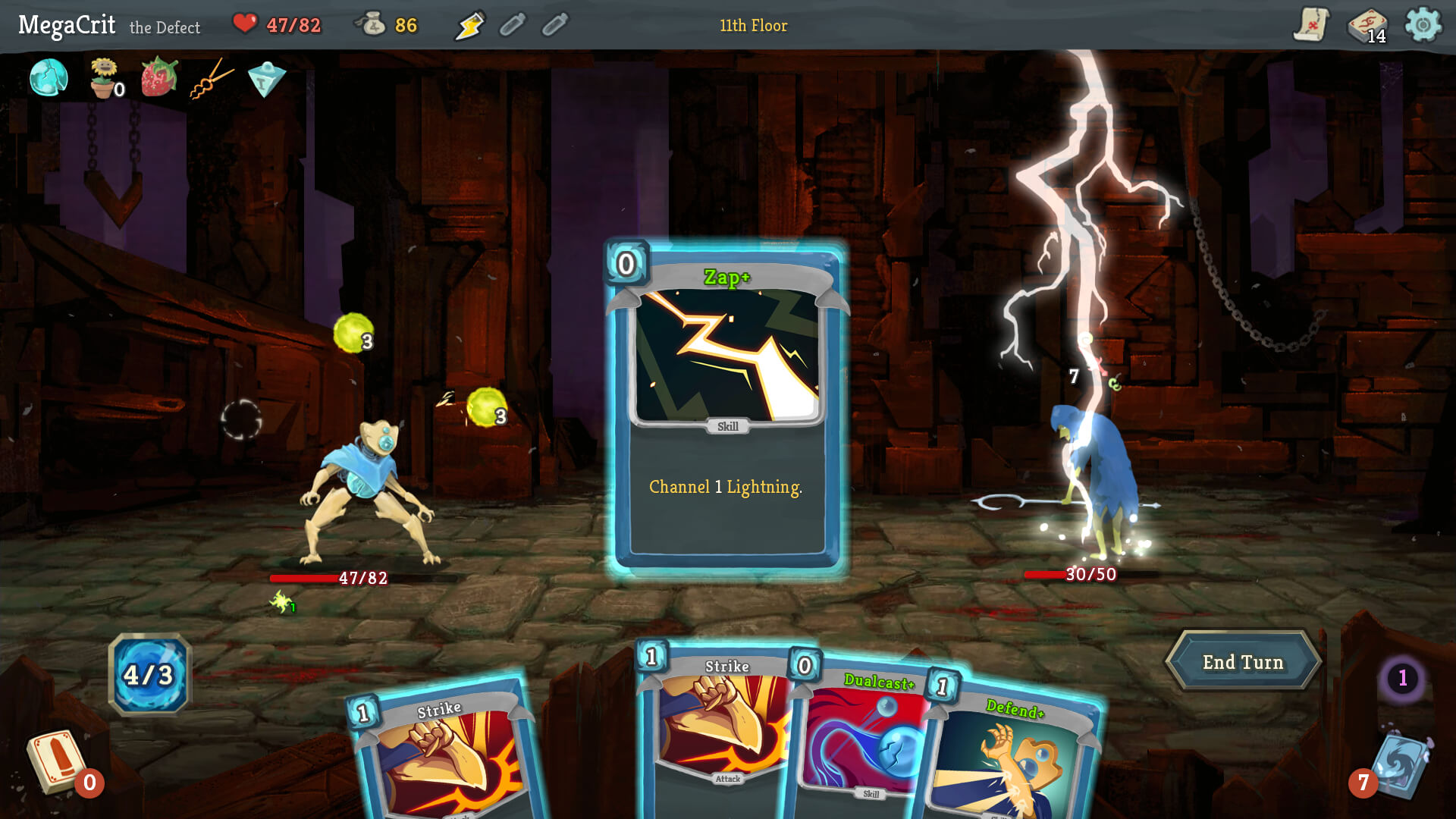
Screenshot from Slay the Spire
Since it’s a digital game, it can do a lot within the space that pre-Arena Magic couldn’t—my favorite of which is shuffling status conditions into your deck. Certain monsters will inflict wounds that persist through the encounter; for example, a slime monster’s attack may shuffle a Slimed token into your deck which, when drawn, clogs up your hand until you spend an energy to exile it. Generally, this is merely a nuisance, but since some archetypes depend upon churning through your deck multiple times per encounter, it can also mean a loss.
There was clearly a Slay the Spire aficionado on the Wizards team as they were creating the Mystery Booster playtest cards; Gunk Slug is effectively a Spire enemy brought into Magic. Magic has experimented with Gunk-style effects before, albeit in very preliminary forms.
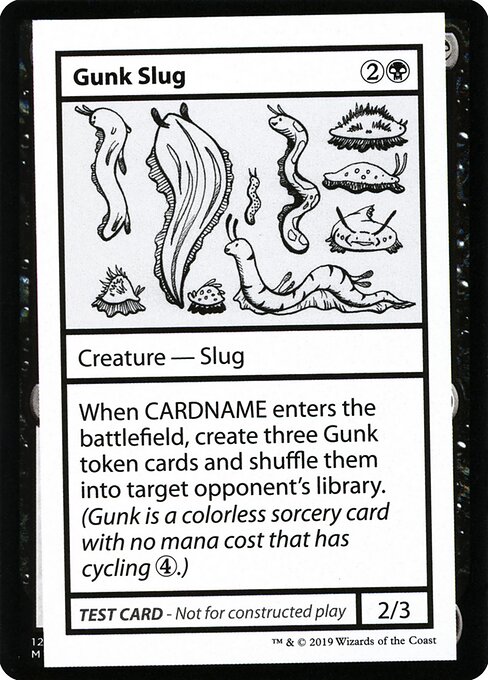
Aaron Forsythe has mentioned that New Phyrexia initially concepted a mechanic where you shuffled cards from your opponent’s deck into your own. There’s no real way to do this in a tournament setting, other than mandate/provide a certain specific sleeve for all players, which really isn’t worth it. But in a more casual setting, there are workarounds—for example: not caring. There’s a reason ante was one of the first core concepts of Magic to meet the chopping block.
In Magic, as in Slay the Spire, Gunk is a griefer ability—it serves no purpose beyond frustrating your opponent and wasting their tempo. Gunk Slug’s rate is low enough that, in an average game of Magic, your opponent is unlikely to even draw a single Gunk token from their deck. Since the Slug is the only Gunk-creator at the moment, we’ll have to jump through some hoops to Gunk up our opponents’ decks. Luckily, Toxrill is in the colors of clone effects and reanimation, so it should be relatively simple to copy, loop, or reanimate Gunk Slug enough times. How, then, do we make the massive Slug the entire table’s public enemy number one?
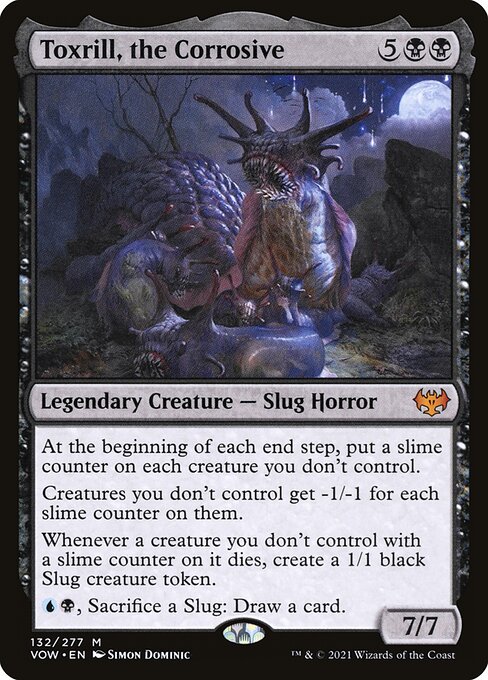
Obviously, the Mystery Booster cards are not Commander legal, so that’s an immediate hitch in our plan. We’ll also need a minimum of 120 Gunk tokens with—ideally—matching sleeves to our opponents’ decks. But if we’re committed enough, and our playgroup is flexible and generous enough, we can turn Toxrill from a board control engine into Slug Frenzy. The Gunk token issue is another matter, but I’ve been writing “Gunk—Sorcery (4): Cycle” on a stack of Midnight Hunt double-faced card placeholders.
EDHREC is my go-to resource for a first draft of a new Commander deck—mostly to see what’s level-one thought and potentially worth avoiding. So far, it seems like Toxrill is a bad Atraxa, Praetors’ Voice, with the most common cards in people’s Toxrill decks Proliferate engines. We’ll still be running some of those in our Gunk deck, as Contagion Engine and Yawgmoth, Thran Physician are simply too perfect; but we’re staying away from the emerging standard for Toxrill.
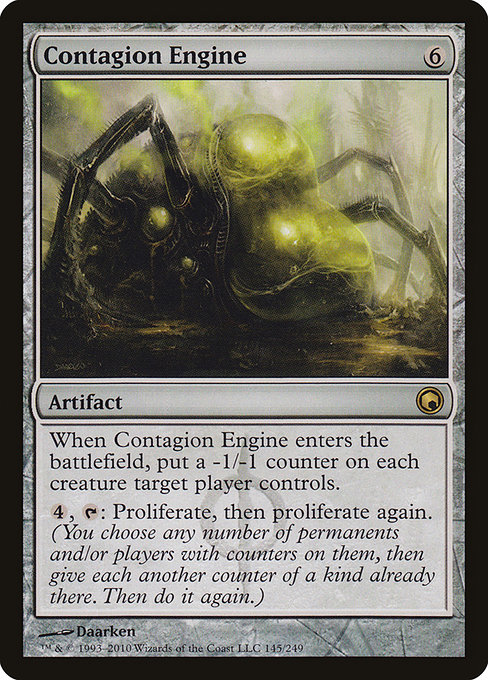
Level one Toxrill decks proliferate slime tokens, give your opponents creatures via cards like Hunted Phantasm, shrink Slimed creatures to kill them via Mass Diminish and Polymorphist’s Jest, alongside favorites like Grave Pact and Dictate of Erebos. That’s all well and good, but we’re a Gunk deck, not a Slime deck!
We’re also not a Slug deck. There are ten Slugs in Magic, including Gunk Slug, and the only ones Toxrill can run are Catacomb Slug, Giant Slug, Gluttonous Slug, and Morkrut Necropod, all of which are completely unplayable outside of Limited. Instead, we’ll be playing a regular game of Magic until it’s time to go Gunk and copy Gunk Slug as many times as possible via Soul Foundry, Rite of Replication, and Infinite Reflection.
Toxrill themself will be our win condition: once our opponents are Gunked into irrelevance, the beefy 7/7 can take out an opponent in three swings. There will be the usual suspects to keep everyone honest: Damnation, Oblivion Stone, The Meathook Massacre, etc. We’re also running a hearty amount of mana rocks, as Toxrill’s cost is hefty.
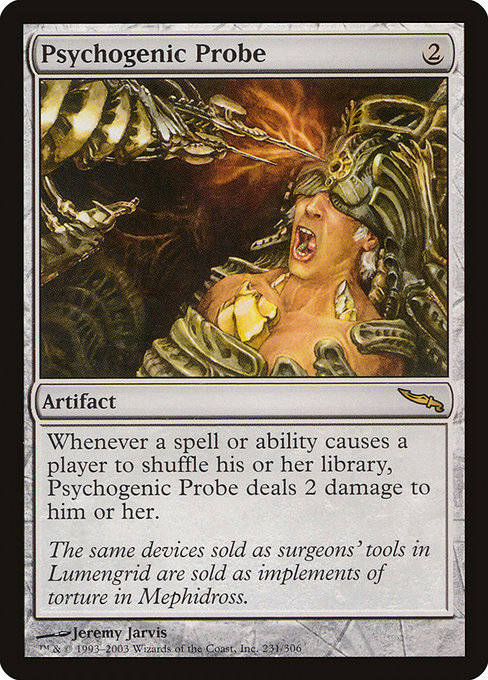
Each time we shuffle Gunk into our opponent’s deck, they’ll take damage from Psychogenic Probe, which we’ve ideally copied with Sculpting Steel or Phyrexian Metamorph, or get further in trouble with Psychic Surgery. Cavalier of Night, Unearth, Palace Siege, Call of the Death-Dweller all help us get back a Gunk Slug, and a whole host of clone effects mean we can gunk up both our opponents’ decks and the board.
Behold blessed perfection:
Commander: Toxrill, the Corrosive
Creatures: Ayara, First of Locthwain, Cavalier of Night, Curiosity Crafter, Deadeye Navigator, Fain, the Broker, Glasspool Mimic, Identity Thief, Gunk Slug, Mercurial Pretender, Mirrorhall Mimic, Nadir Kraken, Phantom Steed, Phyrexian Delver, Phyrexian Metamorph, Pitiless Plunderer, Priest of Forgotten Gods, Sidisi, Undead Vizier, Sludge Monster, Species Specialist, Stunt Double, Thassa, Deep-Dwelling, Trophy Mage, Yawgmoth, Thran Physician
Planeswalkers: Lolth, Spider Queen
Artifacts: Arcane Signet, Booby Trap, Coalition Relic, Conjurer’s Closet, Contagion Engine, Hedron Archive, Idol of Oblivion, Mimic Vat, Oblivion Stone, Panharmonicon, Psychogenic Probe, Sculpting Steel, Skyclave Relic, Sol Ring, Soul Foundry, Sword of Truth and Justice, Talisman of Dominance, Thran Dynamo
Enchantments: Bastion of Remembrance, Followed Footsteps, Infinite Reflection, Kindred Discovery, The Meathook Massacre, Palace Siege, Psychic Surgery, Strands of Night
Instants: Vampiric Tutor
Sorceries: Call of the Death-Dweller, Damnation, Grim Tutor, Necrotic Hex, Pact of the Serpent, Reanimate, Rite of Replication, Unearth, Victimize
Lands: 11 Island,12 Swamp, City of Shadows, Command Tower, Creeping Tar Pit, Drowned Catacomb, Fetid Pools, High Market, Hostile Hostel, Karn’s Bastion, Morphic Pool, Nesting Grounds, Phyrexian Tower, Polluted Delta, Shipwreck Marsh, Sunken Hollow, Watery Grave, Westvale Abbey
Is this deck competitive? No, of course not. Is it legal? Only with the express approval of your playgroup. But it’s been a rough year, and the fact is: being able to say “Okay, so I Soulbond Deadeye Navigator to Gunk Slug” or “End of turn, Vampiric Tutor for Gunk Slug” or, most especially, “Cast Booby Trap naming ‘Gunk’” is the reason I play Magic and the reason I love it.
Magic’s greatest gift to us as players is its myriad opportunities to spark joy. It’s easy to get bogged down in rapid-fire set releases and the hot takes and the deckbuilding that follow in their wake, but occasionally, a big slug shocks you back to your senses. Toxrill works just fine as a more traditional, card advantage-oriented general: he controls the board, grows your board, and draws you cards, so classic Dimir stuff there. But he can also inspire so much more.
We get jaded—we optimize our decks and study the metagame and start Discord channels to hone archetypes—but I guarantee you that there’s a Magic player out there who considers Edgar, Charmed Groom the most unbeatable card ever printed. If it speaks to you, build it—and Toxrill speaks to me.
A lifelong resident of the Carolinas and a graduate of the University of North Carolina, Rob has played Magic since he picked a Darkling Stalker up off the soccer field at summer camp. He works for nonprofits as an educational strategies developer and, in his off-hours, enjoys writing fiction, playing games, and exploring new beers.

